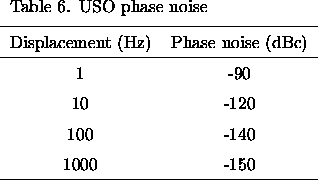


Next: 4.4 USO Test Program
Up: 4. DWE Instrumentation: Ultrastable
Previous: 4.2 USO mechanical/electrical characteristics
The USO long-term frequency stability requirement of
 /
/
 2·10E-10 is critical
for a successful Doppler Wind Experiment.
By "long-term" it is meant that the uncertainty in the frequency
must be constrained within these limits
for the maximum expected duration of the atmospheric descent
(2.5 hours), i.e., the total frequency shift of the PRL signal is
less than 0.4 Hz over the entire Huygens mission.
Assuming a typical DWC angle of 65°, an unwanted frequency
shift of this magnitude would be indistinguishable from
a zonal wind with velocity of
2·10E-10 is critical
for a successful Doppler Wind Experiment.
By "long-term" it is meant that the uncertainty in the frequency
must be constrained within these limits
for the maximum expected duration of the atmospheric descent
(2.5 hours), i.e., the total frequency shift of the PRL signal is
less than 0.4 Hz over the entire Huygens mission.
Assuming a typical DWC angle of 65°, an unwanted frequency
shift of this magnitude would be indistinguishable from
a zonal wind with velocity of  0.15 m/s.
This USO frequency stability is thus mandatory for achieving
the primary DWE goal, a determination of Titan's zonal wind
height profile with an accuracy well below the
0.15 m/s.
This USO frequency stability is thus mandatory for achieving
the primary DWE goal, a determination of Titan's zonal wind
height profile with an accuracy well below the  1 m/s level.
This must be maintained throughout the entire Huygens mission,
in spite of many rather severe changes in the environmental conditions
(temperature T, pressure P, acceleration A and magnetic field B).
Generally, this requirement can be expressed by:
1 m/s level.
This must be maintained throughout the entire Huygens mission,
in spite of many rather severe changes in the environmental conditions
(temperature T, pressure P, acceleration A and magnetic field B).
Generally, this requirement can be expressed by:

where "X" collectively labels other factors, e.g. the variation
of the USO supply voltage.
Typical values for the expected fractional change in the
USO output frequency are listed in Table 4.

Although not as critical as the long-term frequency stability,
the short-term frequency stability is another criterion for the
frequency quality of the USO.
The short-term frequency stability is characterized by the mean
fractional frequency deviation

This quantity, sometimes called the
"Allan deviation", depends on the integration time  (s. also
eq. (26)).
The specified USO short-term frequency stabilities are shown in
Table 5.
These values are sufficient to detect PRL frequency modulations due
to atmospheric turbulence as well as pendulum and rotational
motion of the Huygens Probe.
Table 6 lists the specifications on the phase noise of the output signal
spectrum for various displacements from the center peak.
(s. also
eq. (26)).
The specified USO short-term frequency stabilities are shown in
Table 5.
These values are sufficient to detect PRL frequency modulations due
to atmospheric turbulence as well as pendulum and rotational
motion of the Huygens Probe.
Table 6 lists the specifications on the phase noise of the output signal
spectrum for various displacements from the center peak.





Next: 4.4 USO Test Program
Up: 4. DWE Instrumentation: Ultrastable
Previous: 4.2 USO mechanical/electrical characteristics
DWE Homepage - For further information contact r.dutta-roy@freenet.de
 /
/
 2·10E-10 is critical
for a successful Doppler Wind Experiment.
By "long-term" it is meant that the uncertainty in the frequency
must be constrained within these limits
for the maximum expected duration of the atmospheric descent
(2.5 hours), i.e., the total frequency shift of the PRL signal is
less than 0.4 Hz over the entire Huygens mission.
Assuming a typical DWC angle of 65°, an unwanted frequency
shift of this magnitude would be indistinguishable from
a zonal wind with velocity of
2·10E-10 is critical
for a successful Doppler Wind Experiment.
By "long-term" it is meant that the uncertainty in the frequency
must be constrained within these limits
for the maximum expected duration of the atmospheric descent
(2.5 hours), i.e., the total frequency shift of the PRL signal is
less than 0.4 Hz over the entire Huygens mission.
Assuming a typical DWC angle of 65°, an unwanted frequency
shift of this magnitude would be indistinguishable from
a zonal wind with velocity of  0.15 m/s.
This USO frequency stability is thus mandatory for achieving
the primary DWE goal, a determination of Titan's zonal wind
height profile with an accuracy well below the
0.15 m/s.
This USO frequency stability is thus mandatory for achieving
the primary DWE goal, a determination of Titan's zonal wind
height profile with an accuracy well below the  1 m/s level.
This must be maintained throughout the entire Huygens mission,
in spite of many rather severe changes in the environmental conditions
(temperature T, pressure P, acceleration A and magnetic field B).
Generally, this requirement can be expressed by:
1 m/s level.
This must be maintained throughout the entire Huygens mission,
in spite of many rather severe changes in the environmental conditions
(temperature T, pressure P, acceleration A and magnetic field B).
Generally, this requirement can be expressed by:






 (s. also
(s. also

